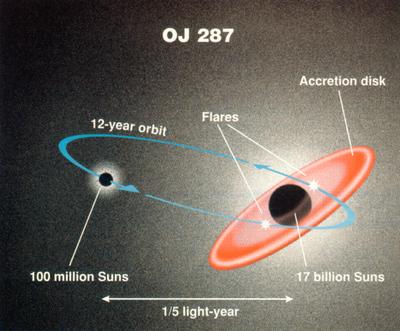

|
An international group of astronomers lead by Mauri Valtonen (Tuorla Observatory) has verified General Relativity as the correct theory of gravitation in strong gravitational field using results from a distant quasar called OJ287. The findings have just appeared in the 17 April 2008 issue of Nature magazine. Continuous monitoring of OJ287 over the last few years has proven correct a decade old model of this quasar as a precessing binary black hole system which produces two major outburst peaks per 12 year orbital period. The occurrence of the latest outburst on 13 September 2007, within a day of the predicted time, finally clinched the model. |

|
OJ287 is thought to be a binary black hole in the centre of a distant galaxy. Both black holes are very heavy -- one equivalent to some 18 billion times the mass of the Sun, while the other weighs in at a mere 100 million times the mass of the Sun. The smaller black hole is on an eccentric orbit around the heavier one, and perdiodically passing through the regions close to the centre of the system, where gas has collected into a so-called accretion disk. The passing of the lighter black hole through this disk causes huge outbursts of energy in the system, showing up at all frequencies from radio to optical and X-ray. The outbursts are seen approximately every twelve years and occur as double peaks. OJ287 is going through such an outburst in 2007, and observatories world-wide are closely monitored it during this particularly interesting phase.
In addition to confirming the precessing binary model, data collected in 2007 proved that the spacetime around the primary in OJ287 curves as predicted by Einstein's theory. All earlier tests of the theories of gravitation have relied on weak fields, and there have been a possibility of different interpretations of the data. For example, the relativistic precession of a binary major axis can be explained by a flat spacetime theory as long as the precession is not too large. However, the 39 degree precession per period in OJ287 is clearly beyond reach of a flat spacetime theory, and proves that the spacetime curvature occurs as in General Relativity. Thus this also proves that the primary in OJ287 is indeed a black hole, a spacetime singularity, not just a heavy body in flat spacetime. Strictly speaking, in all earlier claimed cases of discovering black holes there has only been a proof of a heavy body inside a small volume, not that there is actually a spacetime singularity inside this volume. Thus in a way this is the first confirmed case of a real black hole in the universe.
As a side result, it was shown that the binary system loses energy at the correct rate as calculated for gravitational waves in General Relativity. This is an important result since no gravitational waves have been directly detected so far yet. The rate observed in OJ287 is the highest known gravitational wave energy emission for any object, and the rate is comparable to the total electromagnetic emission of this quasar. OJ287 will be a prime target for the gravitational wave antenna LISA when it becomes operational in the next decade.
Another interesting result is that the primary black hole has the mass of 18 billion solar masses, a record for a supermassive black hole for a short while until Vestergaard et al. reported in 2008 four quasar black holes of greater mass than the OJ287 primary. And finally, OJ287 may be viewed as the first confirmed binary black hole system. In itself, it is not surprising to find a binary black hole system since current cosmological models predict an abundance of galactic nuclei with binary black holes. The outstanding question really is why we haven't discovered more cases like OJ287 yet. The answer may be that the accretion disk in a binary black hole system is unstable unless the primary black hole mass is 10 billion solar masses or greater, and such large black holes are rare in the universe, as Vestergaard et al. have shown. Thus there may indeed be plenty of galaxies with binary black hole nuclei, but we do not a get such a clear binary signal from them as we do from OJ287. The existence of an accretion disk is essential for the quasar phenomenon in general, and for the recognition of binary black hole systems in particular.
The discovery of the OJ287 binary black hole system is a result of an extensive monitoring program of quasars carried out both in radio (Metsähovi Radio Observatory/Helsinki University of Technology) and in the optical (Tuorla Observatory/University of Turku) which started in 1980 with the prime purpose of searching for periodic behaviour and evidence for binary systems. The recent confirmation of the OJ287 binary depended also heavily on the polarimetric observations at the Nordic Optical Telescope, a project which was also initiated in 1980. This is yet another example of the need for long term commitment in scientific research.
Link to more information on OJ287's orbit and mass
"Huge Blackhole tips the scales" -- a BBC press release on Tuorla led research on OJ287
Very extensive information on OJ287 monitoring is available from Tuorla's monitoring pages.